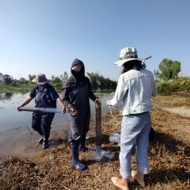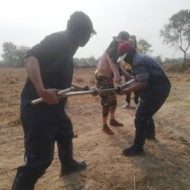Magnitude and factors influencing soil loss and sedimentation in the Mun River Basin, Thailand
Highlights
- Mun River Basin is in NE Thailand and a part of Lower Mekong Region
- High soil loss and sediment loading were found in upper basin since land conversion
- Agricultural practice was mostly responsible for the loss
- Sediment cores showed high deposition rate in middle basin, up to 5.2 cm yr-1
- Sediment in lower basin was significant to sediment balance in Mekong region
Researcher Name: Asst. Prof. Dr. Arika Bridhikitti
Years of execution: 2019-2021
Funder Name: National Research Council of Thailandco-funded by the National Natural Science Foundation of China
Objectives:
- To provide understanding on the sedimentation process in the whole Mun River Basin.
- To assess the effects of ENSO and conservation practices (P-factor) on the soil loss
Abstract: Previous studies have shown potentially high soil loss in the Mun River Basin, the largest sub-basin of the Lower Mekong Region in Thailand, due to its rapid land cover changes, agricultural practices, and soil erodibility properties. This study aims to estimate the soil loss and sedimentation rates in the Mun River Basin using the analysis of long-term sediment loading data from the Royal Irrigation Department (RID), GIS-based Revised Universal Soil Loss Equation (RUSLE) approximation, and sediment core analyses. This study found that a high loss (> 12.5 ton ha-1 yr-1) and RID sediment loading rate were predominant in the upper basin. The support practice was most sensitive to the loss, but during extreme rainfall events (El Niño Southern Oscillation), the role of rainfall intensity was more pronounced. Therefore, mechanical measures should be adopted in combination with the soil-water conservation practices to mitigate the effects in eroding agricultural areas. Sediment core analyses revealed that the highest sediment deposition rate was up to 5.2 cm yr-1 in the middle part of the Mun River Basin, primarily due to the floodplain lowland characteristics and repeated flooding events. Several factors influenced the sediment deposition rate: installation of dams or check dams, waterway maintenance, upstream land cover, water plant outgrowth, and flooding. The RID sediment loading also suggests that sediment mass transfer to the Mekong River was highly contributed from the lower basin, where the sediment from the upper part was either trapped by the dams or deposited within the channel.
Reference: Bridhikitti, A., Ruamchalerm, P., Keereesuwannakul, M., Prabamroong, T., Liu, G., & Huang, C. (2022). Magnitude and factors influencing soil loss and sedimentation in the Mun River Basin, Thailand. CATENA, 210, 105872.







